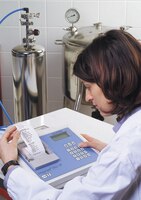Integrity Testing

Recommended Products
Overview
Specifications
Ordering Information
Documentation
Related Products & Applications
Categories
| Biopharmaceutical Manufacturing > Downstream Processing > Sterile Filtration > Integrity Testing |
Non-Destructive Testing
Integrity testing sterilizing filters is a fundamental requirement of critical process filtration applications in the beverage industry.
Two classifications of integrity testing are destructive and non-destructive. Millipore's practice is to perform destructive testing and non-destructive testing on lot samples of membrane filters to insure integrity.
Non-destructive testing may be done on filters before and after use. Integrity testing, performed before the sterilizing filters have been used, monitors filter integrity prior to batch processing to prevent the use of a non-integral filter. Integrity testing, performed after a batch has been processed, can detect if the integrity of the filter has been compromised during the process. Detecting a failed filter alerts operators to a problem immediately after batch processing and eliminates delay by keeping batches under control.
There are three types of non-destructive testing: bubble point test, diffusion test and water flow integrity test for hydrophobic filters (the HydroCorrSM Test). The pressure hold, forward flow, and pressure decay tests are variations of the diffusion test. In Beverage applications, it is recommended to perform filter integrity testing during the final membrane filtration step.
Bubble Point Test
The most widely used non-destructive integrity test is the bubble point test. Bubble point is based on the fact that liquid is held in the pores of the filter by surface tension and capillary forces. The minimum pressure required to force liquid out of the pores is a measure of the pore diameter, see Bubble point formula:
Where
k = shape correction factor
Ύ = surface tension
ɵ = contact angle
d = pore diameter
Bubble Point Procedure:
1. Wet the filter with water for hydrophilic membranes or an alcohol/water mixture for hydrophobic membranes.
2. Pressurize the system to about 80% of the expected bubble point pressure as stated in the manufacturer's literature.
3. Slowly increase the pressure until rapid continuous bubbling is observed at the outlet.
4. A bubble point value lower than the specification is an indication of one of the following:
- fluid with different surface tension than the recommended test fluid
- integral filter, but wrong pore size
- high temperature
- incompletely wetted membrane
- non-integral membrane or seal
Diffusion Test
At differential gas pressures below the bubble point, gas molecules migrate through the water-filled pores of a wetted membrane following Fick's Law of Diffusion. The gas diffusion flow rate for a filter is proportional to the differential pressure and the total surface area of the filter. At a pressure approximately 80% of the minimum bubble point, the gas which diffuses through the membrane is measured to determine a filter's integrity.
Diffusion Test Procedure
1. Wet the filter with water for hydrophilic membranes or an alcohol/water mixture for hydrophobic membranes.
2. Slowly increase pressure on the upstream side of the filter to the recommended test pressure provided by the manufacturer
3. Allow the system to equilibrate.
4. Measure the gas flow at the outlet for one minute with an inverted graduated cylinder or a flow meter.
5. A diffusion flow reading higher than the specification is an indication of one of the following:
- wrong pore size
- temperature other than ambient
- incompletely wetted membrane
- non-integral membrane or seal
- inadequate stabilization time
Pressure Hold Testing
The Pressure Hold Test, also known as pressure decay or pressure drop test, is a variation of the diffusion test. In this test, a highly accurate gauge is used to monitor upstream pressure changes due to gas diffusion through the filter. The pressure hold value is dependent on the diffusion flow and upstream volume. It can be calculated using the following equation:
where:
D = Diffusion rate (mL/min)
T = Time (minutes)
Pa = Atmosphere pressure (1 Atm)
Vh = Upstream volume of apparatus (mL)
ΔP = Pressure Drop (bar or psig)
Pressure hold testing is the method employed by most automated integrity test systems.











